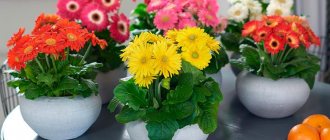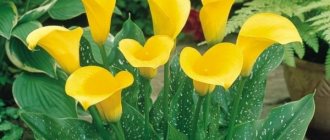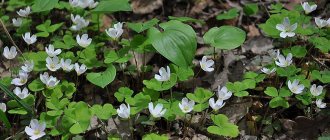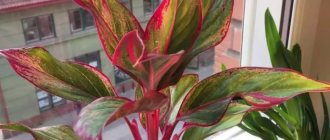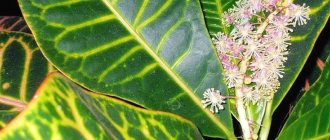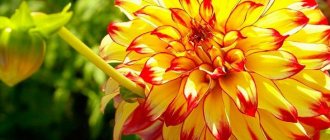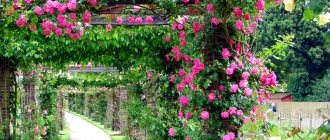Each of us tries to make our home more comfortable and cozy. Flowers add undeniable comfort to any apartment or house, and it is also useful, because indoor plants perform the function of purifying the air. Archaeological science, based on pollen found in caves, has proven that even in the Stone Age, people decorated their homes with flowers. Today, indoor floriculture is a separate science, and from all the variety of house plants, we present the most beautiful indoor flowers.
18 most beautiful types of indoor flowers:
1
Clivia
The beautiful evergreen plant is named after Duchess Charlotte Clive, who was governess to the future Queen Victoria of Great Britain.
This flower arrived in Europe from South Africa, easily took root in northern latitudes and became a favorite of most gardeners.
An unpretentious plant will decorate any home or office space, but you must try not to move the pot and water it once a week.
2
Indoor climbing plants (photos and names)
Multi-flowered jasmines (lat. jasminum polyanthum)
They are classified as liana plants. Jasmine blooms with white star flowers, 5 petals each. Attractive strong aroma. This plant will perfectly decorate the interior, as it is evergreen, and its climbing vines look very impressive.
Jasmine multiflorum
The pot is placed in bright sunlight and watered twice a week in winter, and once every 2-3 days in the warm season.
ADVICE!
Jasmine loves humid air and spraying!
Unlike many flowers, jasmine loves to be fed not during flowering, but after it for 6 months in a row.
The vine grows up to 2 m and grows for about 10 years in a greenhouse or glassed-in loggia. The apartment is decorated with jasmine for no longer than six months.
Crassula
The round leaves of this plant look like coins, which is why Crassula is often called “money tree” or “crassula” among gardeners.
When it blooms, it is covered with small white flowers, sometimes red, and very, very rarely the flowers can be blue.
One of the most unpretentious room dwellers. Even a leaf that falls to the ground can sprout into a separate plant.
3
Placing flowers in the house and apartment
Planning to create a certain atmosphere in a room using greenery begins with developing a sketch. This will allow you to determine the required dimensions and select a specific type of decorative crop. When placing indoor flowers and plants in the interior, we focus not only on their features, but also take into account the general rules:
- Do not install pots next to heating appliances. Prevent plants from getting cold air currents during ventilation;
- Light-loving crops are placed closer to sources of natural light. If necessary, provide additional lamps.
- Organize systematic care based on knowledge of the characteristics of each individual plant. When distributing plants in space, it is important to create a harmonious environment.
- For climbing plant varieties, fixation of vertical supports is provided. They are also hung in special flowerpots on walls or in window openings.
Furniture facades or wall surfaces most often serve as a background for greenery. Large-leaved indoor plants are recommended to be installed in rooms where the walls are decorated with wallpaper with small patterns. Small-leaved plants look great against the background of plain pastel surfaces.
Advice! To achieve a logical conclusion to the overall composition, textiles and decorative details are selected taking into account the colors of the plants placed in the room.
A combination of plants of different heights looks advantageous. You can create an elegant composition of indoor flowers with foliage of various shapes, sizes, and colors.
They also pay attention to the appearance of flower pots, flowerpots, and cache-pots. They must match the size of the plants planted in them. The color and texture of the containers are selected in accordance with the style of the interior, as well as taking into account its color scheme. It is possible to add original accents to the atmosphere of your home if you use pots with a colorful design or an unusual shape.
On a note! It is important to show a sense of proportion so that the room does not turn into a greenhouse or a museum of plant forms.
Flowers and plants on the windowsill
tall flowers on the windowsill , which will reduce the intensity of lighting in the room. Pay attention to compact varieties, examples of which are violets, fittonia, and balsam.
To create a harmonious composition, pots with low plants are selected in a single color scheme. Place them on the windowsill in a rhythmic pattern, without cluttering up the limited area. Crops that require identical care are placed in a common, beautifully shaped container, creating an orderly, neat atmosphere.
On a note! You can create a composition in several levels if you place a low table under the windowsill for taller flowering crops.
Flowers on a stand
Flowers with a lush, spreading aerial part and many buds look more impressive alone. It is advisable to install crops with tall stems and large leaves on low-height floor stands. You can place flowerpots directly on the floor.
Interesting options for including plants with leaves and petals of different shapes and colors are obtained by installing flowerpots on forged, wooden, or plastic elegant stands. The number of levels is selected depending on the area of the room.
Vertical gardening
The trend in modern apartment design is vertical gardening of premises in various options:
- green partitions and walls;
- ceiling installations;
- mobile compositions of greenery;
- phyto-paintings;
- hanging spatial compositions;
- plant modules.
Plants stretching vertically upward visually raise the ceiling. Ivy and vines look expressive against the pastel background of the walls. Tradescantia and cissus create an interesting effect.
Next to walls decorated in dark colors, crops with bright buds and light or variegated foliage should be installed. Vertical stripes on wall planes will become dynamic in the vicinity of spreading openwork plants.
Using a variety of devices, you can create vertical green compositions from plants that saturate the atmosphere with beneficial compounds that lift your mood and improve sleep. Their list includes begonias, valerian, lavender. Citrus fruits, geranium, and myrtle also have a calming effect. Crops such as laurel, rosemary, and gardenia help relieve anxiety and provide comfort.
Live zoning
Using wisely indoor flowers and plants in the interior , it is possible to identify different functional zones in one room, provided that the varieties of indoor crops are competently selected, taking into account the area and the existing microclimate.
Not only flowering plants are used in the compositional solution of space, but also representatives of the flora with decorative leaves. Easy to care for, unpretentious cacti, delicate ferns, elegant palm trees, majestic ficus, and graceful climbing ivy fit elegantly into the interior.
To identify individual zones, different methods are used:
- Open shelving . Climbing and small-leaved indoor crops are placed on shelving shelves that are open on both sides. Over time, they form an openwork screen. To create a living partition, ragwort, pilea, cissus, soleirolia, hedera, tiny ficus, etc. are used.
- Floor flowerpot . Tall plants, as well as varieties with large decorative leaves, are planted in floor pots. Such green compositions are characterized by mobility. They can be easily moved to another location if you need to highlight a specific functional area. Ficus, anthurium, and philodendron perform excellent border roles. Monstera, Dieffenbachia, and Alocasia are often used. Containers for outdoor plants must be stable and durable.
- Zoning from above . Cascades of openwork leaves and climbing stems descending from ceiling mounts in the form of hooks or shelves look impressive. It is advisable for the upper zoning to plant ampelous ornamental crops, for example, chlorophytum, scindapsus, aeschynanthus, asparagus, columna, hoya.
- Green wall . When climbing plants are placed quite densely on a partition or network plane, an original composition is obtained. Flowerpots are often fixed on a special lattice or hooks are mounted in a certain rhythm.
- Plant border . By establishing a line that visually distinguishes one of the zones in the room, crops that bloom at different times get an elegant border. You can use plants that differ in the height of the stems, colors of buds and foliage.
Lithops
Photo credit: Dornenwolf / flicr
Translated from ancient Greek, the name of the plant translates as “stone appearance,” perhaps because it comes from the rocky and sandy deserts of Namibia and Botswana.
That is why Lithops has learned to retain moisture and easily tolerate heat and arid climates.
The flowers of the desert dweller who migrated to apartments are white or yellow; very rarely there are varieties with orange petals.
4
Croton
This species, growing in tropical and subtropical zones, has long become popular among flower growers around the world.
Its bright leaves will add variety and uniqueness to your home, or will become a real decoration for your office. Due to its shape it has become very popular among amateur gardeners.
The plant is easy to care for, and some of its species grow up to 80 centimeters in height.
5
Indoor poisonous plants (photos and names)
Before you buy any indoor plant, make some inquiries - what if your plant is poisonous, and despite its external beauty, you shouldn’t bring a potential threat to all inhabitants into the house?
Dieffenbachia
The advantages of the beautiful Dieffenbachia: tall growth, spreading burdock leaves with different color options, the ability to improve the quality of the air around it... but the plant juice is poisonous! If the integrity of the plant is damaged and the poison gets on the skin or mucous membranes, then gastrointestinal and respiratory problems are possible. If juice gets on your skin, burns may occur.
ATTENTION!
Caring for Dieffenbachia is carried out only with gloves!
Dieffenbachia
Dieffenbachia often grows as a spreading bush
Euphorbia
If a curious child picks the skin of a plant and sees white juice, so similar to milk, then the following consequences are possible: diarrhea, nausea, dizziness, serious burns of the mucous membrane.
The milkweeds themselves are varied in form and, of course, beautiful. However, such beauty is not worth the risk.
Spurge
Euphorbia is very similar to a cactus with leaves.
Aloe striped, Aloe intimidating
The medicinal form of aloe looks like poisonous ones, the difference lies in the color of the plants. Striped and frightening can cause miscarriage, uterine bleeding, and serious disturbances in the functioning of the stomach.
Aloe awesome
Bromeliad
They named the indoor flower and the entire genus in honor of the Swedish biologist Bromelius. This tropical beauty is a distant relative of the pineapple.
Their leaves are lancet-shaped, they are collected in a kind of rosette from which the peduncle grows. Bromeliads require watering only once a week, but bromeliads should be placed in places that receive sunlight.
Flowering lasts from 3 weeks to several months, delighting the owners and guests of the house.
6
Phalaenopsis white
This simplest and most unpretentious representative of the orchid family is the most popular. White phalaenopsis is able to bloom almost the whole year, because the flower buds bloom gradually, and each snow-white butterfly flower lives from two to three months. The flower can form up to four peduncles, each with 6-12 buds.
Phalaenopsis has a short stem and long, oval, densely textured leaves that grow from a single point. The orchid does not strive to increase green mass and, when releasing a new leaf, it sheds one of the old ones. Therefore, more than six leaves can rarely be observed on a plant. The peculiarity of the orchid is that it produces fleshy aerial roots of a greenish flower, which can even form in the axils of the leaves.
The average lifespan of Phalaenopsis is about seven years, during which time the flower requires quality care:
- You can place the orchid in the back of the room, with enough diffused light. The optimal length of daylight is 14 hours. Therefore, you should take care of artificial lighting in advance. The suitable temperature for keeping the flower is 23-25 degrees.
- Phalaenopsis must be watered correctly so that drops of water do not fall on the leaves, especially in the center of the rosette. Excessive moisture causes the plant to rot. Irrigation procedures are carried out using water mist or the immersion method, when the flower collects the required amount of moisture through the drainage hole. If water does get into the outlet, it must be dried with a paper napkin.
- The butterfly orchid needs regular feeding throughout the season. Special fertilizers are applied 30 minutes after watering. When choosing a fertilizer, you should pay attention to its composition; if the fertilizer contains components that stimulate the formation of buds, then only healthy and developed specimens can be fed with it.
- The soil for orchids must contain the bark of coniferous trees. The plant is replanted every two to three years or when the roots completely entwine the earthen ball and begin to rise above the pot. The procedure is carried out after flowering has ended.
Caring for such a “snow white” is quite troublesome, because she is capricious. But, if Phalaenopsis likes the conditions, it will reward you with lush and long-lasting flowering.
Geranium
This beautiful indoor plant also has bactericidal properties, so it will not only decorate the room, but will also be useful.
In order for geraniums to bloom constantly, it is necessary to pick off the already fading flowers.
The plant is unpretentious and does not require spraying or frequent watering. Because of its beauty and originality, geranium is one of the most popular inhabitants of apartments and offices.
7
Fruit houseplants, their photos and names
There are indoor indoor plants that will not only decorate your living space with their appearance, but will also bear edible fruits. Here are the names and photos of some fruit-bearing indoor plants: lemons, tangerines, kiwi, figs, pineapple, mini peppers and even pomegranate.
Indoor lemon
It differs from its relatives in dwarf varieties that bear fruit in apartment conditions and bear up to 20 lemons. Indoor lemon smells very strongly, corresponding to its name, and is very decorative, because it does not have a dormant period, and on the tree you can always see green glossy foliage and flowers, and lemons.
The plant needs additional lighting and warmth, but it is better to cover heating devices, if they are nearby.
Indoor lemon
Figs
In the house it begins to bear fruit in the first year. They care for figs just like lemons, but remember that the tree sheds its leaves at the end of October. A rest period is required; it is tedious to move the figs to a cool place and shade them with a dark cloth. It is good to lower the tree into the basement and water it as little as possible. After a while, the plant will begin to develop new buds, which means it’s time to return the figs to the bright windowsill.
Figs
We covered a very small part of the catalog of indoor plants, but we hope that our article turned out to be informative and educationally useful.
Alocasia
The exotic queen of the tropics has just begun to win the hearts of sophisticated flower growers. Unusual, original shaped alocasia leaves will decorate any room.
In addition, it is unpretentious and does not require special care. Interestingly, different species have different numbers of leaves, but during flowering many plants have only one leaf.
In nature, some species grow up to 2 meters in height, but domestic relatives are from 20 to 40 centimeters.
8
Spathiphyllum
According to legend, this beautiful home flower helps girls meet their betrothed and find feminine happiness.
But with such abilities, it requires special attention to itself, and one cannot say that these are unpretentious indoor flowers. It does not like drafts, but it is better to water it using the cycle method with settled water.
During its flowering period it requires more moisture, but the sun is not so important for it, so it can also grow on windows facing north.
9
Indoor flowers: photos and names in alphabetical order
In catalogs, indoor flowers with photographs and names are usually arranged alphabetically, their homeland, requirements and other data are indicated. We propose to get acquainted with groups of indoor plants and several of their prominent representatives.
Indoor rose
What could be more beautiful than a rose, especially when it blooms on your windowsill. But this queen of flowers requires special care.
The home rose simply loves sunny color, so it is better to place it in a well-lit place on a western or eastern window.
If you care for them properly, roses will bloom all year round, every 7-8 weeks.
10
Fuchsia
Once upon a time, flowering indoor plants accepted fuchsia, a native of Australia and Latin America, into their family. And what is noteworthy is that she immediately took a leading position in home floriculture.
This flower was also revered by the American Indians, and the Incas considered it sacred and decorated their homes and places of worship with flowers.
Fuchsia is unpretentious, and the only thing it really loves is the diffused sunny color. On the pages of the website most-beauty.ru we wrote about this plant in an article about the most beautiful flowers in the world.
11
Photos of indoor flowers that should not be kept at home
For some reason, many people believe that indoor plants are harmless and simply decorate their living rooms. However, there are a number of scientific reasons that claim that not all plants can be kept at home. There are also folk beliefs associated with the energy of flowers.
Some plants emit or contain dangerous allergens and toxic substances. These are some types of ferns, aglaonema, euphorbia, oleander, monstera, alocasia, some ficus, anthurium, clivia, croton, poinsettia, rhododendron, cyclamen, lilies.
Poinsettia
Aglaonema Alocasia Monstera
Oleander
Croton
If you believe in folk superstitions, then refuse to keep ivy of any kind at home - you will remain an old maid, and throw away all the cacti - your husband will become an alcohol addict. What should those who don’t have a husband do? Leave the cacti alone and let them grow. And if you want freedom and loneliness - go ahead, get the ivy!
Hibiscus
But this is not really a flower, but a shrub that came to the Old World from the hot tropics. Evergreen hibiscus, blooming from early spring to late autumn, will decorate the room.
It should be kept in the southern part of the house, where there is a lot of light, and watered regularly and preferably with settled, not cool water.
The only thing that this most beautiful of shrubs cannot tolerate is sudden temperature changes and drafts.
12
Hippeastrum
Often this representative of indoor fauna is mistakenly called Amaryllis; in Greek it is a combination of two words “horseman” and “star”.
A flower with a romantic name loves bright light and is very thermophilic. This is not surprising, because he arrived in Europe and America from the warm latitudes of South Africa.
When flowering, it produces magnificent bright red or pink corolla-shaped flowers.
13
Hyacinth
This house flower, a member of the large Asparagus family, can bloom in a variety of shades from bright red to white and purple.
Recently, due to its original shape and beauty, it has become a fairly common species among gardeners. In addition to the house, there are species that get along well in the garden.
Hyacinth flowers are widely used in the perfume industry, and during the flowering period, hyacinth itself has a pleasant aroma.
14
Decorative foliage plants
Some plants are endowed with the beauty of blooming flowers, others with decorative foliage. If flowering plants simply cannot take their eyes off the flowers, then decorative deciduous plants cannot boast of beautiful flowering, but they benefit from the beauty of foliage, which is painted with intricate patterns.
Miniature indoor plants with decorative foliage are represented not only by ground cover species, among them there are also tiny trees.
Nertera
A ground cover, herbaceous plant belonging to the Rubiaceae family. In its natural habitat it can be found in Australia, Central America, and New Zealand.
Nertera Grandskaya
The perennial prefers cool conditions in winter (+10 °C), in summer – +20 °C. The berries that grow on the plant in large quantities give the plant a special charm.
Attention! The berries are not edible! When growing nertera at home, pets should not be allowed to feast on these “balls,” as the berries are toxic to pets.
They are also unsafe for children. Therefore, the pot with nertera must be placed in an inaccessible place.
Soleirolia
An interesting plant that attracts the eye with thin, oval leaves. Adult specimens look like a green ball. Breeders have developed varieties with green, golden and silver foliage. Saltroots do not take up much space and can be grown as a ground cover plant. They decorate bottle gardens and terrariums. Look beautiful in a hanging flowerpot. Some gardeners decorate the bottom of the aquarium with it.
The unpretentious plant is practically not damaged by pests; only at low air humidity can spider mites appear. Saltirolia creates a favorable atmosphere.
Fittonia
Seeing Fittonia in a store window, it is very difficult to resist buying a plant. Compared to other miniatures, Fittonia costs much less, and its decorative, painted foliage will drive even the most fastidious gardener crazy.
A variegated meadow can be created from several varieties of Fittonia, distinguished by white, green, light green, red and burgundy foliage. However, ease of care does not mean that the plant can safely develop under any conditions. You need to remember that Fittonia needs high air humidity, otherwise it will not reveal itself in all its glory, and growth will stop: it will not live, but survive!
cacti
Be that as it may, but a prickly flower during the flowering period, even if this happens very rarely, you simply cannot take your eyes off them.
And it can please you with flowering only with proper care and compliance with watering requirements. Everyone probably knows that cacti are not watered in winter.
This is a heat-loving plant, so it loves bright light and prefers to be in the southern part of the house.
Palms and trees
Chamaedorea
This bamboo palm is considered very low maintenance. A spreading beauty from Central and South America has arrived. Such palm trees are often used to decorate offices, hotels, and the halls of business centers.
Basic care requirements: moderation. Moderate lighting, since in the shade the palm tree will wither, and in bright light its leaves will get burned. Moderate watering - the earthen ball should be constantly wet, but not waterlogged due to the owner’s zeal! In winter, watering is reduced and the palm tree is kept at a temperature of 15 degrees.
Hamedorea
Begonia
Graceful and majestic begonia has long won the hearts and souls of flower growers and lovers of beauty. It is noteworthy that leaves and flowers can take on a variety of, and sometimes quite bizarre, shapes.
Loves sunny color and regular watering. With proper care, it will delight you with the blooming of beautiful colorful flowers.
This genus is the most common and numerous in the large Begonieceae family, and somewhere in space there is an asteroid named after this flower.
16
Poinsettia
The first Spaniards who arrived in South America met a beautiful flower in the tropics, and local ethnic groups spoke about its healing and magical properties.
The second name simply screams about the magnificence of the plant - the most beautiful Euphorbia, and today it is widespread as an indoor flower in every corner of the world. For a long time there was a misconception that the plant is poisonous, but this is not so. It is harmless and even useful, ionizing the air in the room where it grows.
17
Schlumberger
A flower with such an unusual name belongs to the cactus family, but among gardeners there are many names: “Decembrist”, “Christmas cactus” or simply “Christmas cactus”.
When it blooms, it usually blooms very luxuriantly and for a long period of time. It is better to place it in bright places, but without direct sunlight. Like all cacti, it requires moderate watering, but during the flowering period it is necessary to water it abundantly and maintain high air humidity.
18
Beautifully blooming indoor flowers with photos and names
This group is the favorite for many gardeners. Bright colors of flowers, a wide variety of plants, it’s easy to choose a flower that will fit perfectly into the conditions of the apartment. Representatives of this group have certain requirements for habitat and care. For successful flowering, such plants require fertilizer with the optimal composition, so use fertilizer marked “For flowering plants.”
Azaleas or Rhododendrons Sims (lat. rhododendron simsii)
These are small shrubs strewn with bright large flowers. The foliage is dark green in color, the leaves are pubescent on the underside, and have a dense leathery covering on the front. The small leaves very favorably set off the magnificent white, red, pink, and sometimes two-color buds. The flower petals can be double or simple, but they are all quite large in size.
Azalea requires bright light, but allows partial shade. Abundant watering is needed during flowering at intervals of 2-3 days. In other periods, it is enough to water the flower up to twice a week. The optimal temperature does not exceed 15 degrees.
ADVICE!
It is better to place the azalea on a tray of gravel and keep it moist. Flowers must not be wetted!
Rhododendrons do well in heather soil and in a shallow, wide container. Non-lime fertilizer should be applied once a month. Azaleas live up to 7 years if they are well cared for and taken out onto the veranda during the dormant period. But the life of this riot of colors in the apartment is limited to a few weeks.
Rhododendron: what kind of flower is it? In a special publication on our portal, we will tell you in detail about this unusual flower, what types it comes in, what beneficial properties it has, how to properly grow, propagate, feed and prune.
Anthurium (lat. anthurium)
Popularly called “male happiness” or “tongue of fire”. The plant is a perennial, blooming red all year round. The inflorescence can be pink, yellow, white, always in the form of a cob. Heart-shaped leaves of dark green color on long petioles reach 40 cm. The height of the plant ranges from 40 to 80 cm, growing half a meter in width.
A man's happiness lasts for 3 years, then the leaves fall. To make the flower comfortable, partial shade or diffused light is required in the complete absence of drafts. Watering is carried out once every 4 days, fertilizing is carried out every three weeks during the warm period of the year.
ADVICE!
Anthurium needs to be sprayed daily and at the same time manage not to get any drops on the inflorescence.
Special requirements: at temperatures below 10˚C, the leaves turn yellow and fall off. To make hibiscus bloom better, trim their stems in March, leaving only 2 eyes on each.
Gloxinia (lat. sinningia)
It is a flowering plant that reproduces by tubers. If you are unfamiliar with this plant, bought it, admired its beautiful large gramophone flowers from April to August, and then suddenly the plant disappeared and dried up - don’t rush! The peculiarity of gloxinia is such that when it fades, it will most likely retire, leaving nothing but bare earth as a reminder of itself. Meanwhile, the tuber will undergo an important life period. The soil is suitable deciduous heather with humus.
Gloxinia leaves are beautiful in themselves: long, up to 20 cm, with delicate fluff and edges resembling scallops, they are arranged in a rosette. The plant itself does not exceed 30 cm in height.
The flower responds favorably to diffused sunlight, but it does not like direct sunlight.
There is no need to waste time on spraying - it is contraindicated for leaves. And you need to water the beauty once every three days by lowering the pot into settled water at 22-25 degrees for 10-15 minutes.
IMPORTANT
The earth ball should not dry out completely between waterings!
From the end of September, watering is reduced, and after the leaves fall until new shoots appear, the plant is not watered.
Primrose
Let’s complete the review with a representative of the Primrose family, the most beautiful and original flower, Primrose. The name in Latin is exactly that - “first”.
Whole, carved leaves form a basal rosette. But the primrose blooms with multi-colored flowers of bizarre shapes and an incredible aroma.
It is best to place primroses in brightly lit places, but without direct sunlight, in the southern part of the apartment or house.

